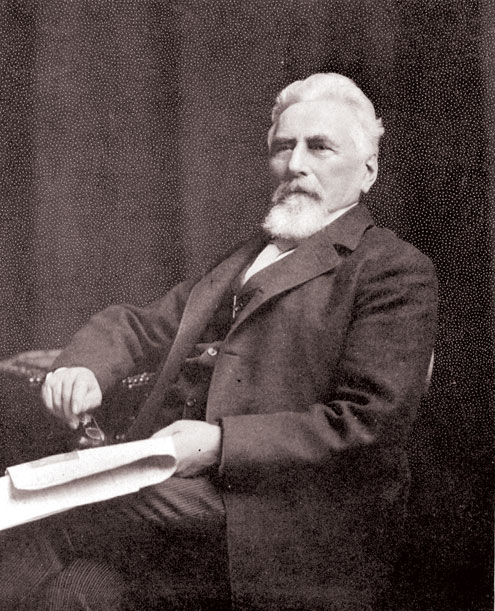By Kevin Newhouse

Prior to his death in 1913, F.A. Hihn was considered Central California’s “most important citizen.” He had the greatest land holdings, paid the most in property taxes, and was Santa Cruz’ first self-made millionaire. At one point in time he owned most of Aptos Village including the Apple Packing Barn, which has been a hot topic of discussion recently.
Hihn’s list of accomplishments, in addition to his real estate holdings, is quite impressive. With Elihu Anthony, Hihn developed the Santa Cruz water system in 1856. He was an investor in the Santa Clara Turnpike Company in 1856 (first wagon road between Santa Cruz and San Jose). He was the founder of Camp Capitola in 1869. He helped organize Santa Cruz City Bank and City Savings Bank of Santa Cruz. He owned multiple sawmills including ones in Aptos and Valencia. He was a Santa Cruz County Supervisor and went on to serve as State Assemblyman from 1870-1872. The list goes on and on.
There are so many stories of his successes and accomplishments that it starts to become a bit overwhelming. Of all these stories though, my favorite is how Hihn actually ended up in Santa Cruz.
At 19-years-old, the German native left home for the west coast of California. Success did not come quickly. A major storm washed away his hopes of making it in the gold fields. His next venture, a candy manufacturer, was also ruined by storm. He became the proprietor of a hotel in Sacramento, but business was bad and he sold his interest in order to move to San Francisco. He opened a drug store, which suffered through two separate fires. Through all this hardship, Hihn never gave up.
In 1851, Hihn and his business partner were heading to Mission San Antonio with a load of goods and a plan to set up a store. Based on the accounts documented in Hihn’s journal, they were near Soledad, heading south, when discouragement reached its peak. The following is an excerpt from Hihn’s journal:
September 17, 1851 – On our way for San Antonio. Got into deep sand, horses could not pull the load. My partner wanted me to whip them. I refused. Got off the wagon and said I would not go any further. He drew his pistol and said he would kill me. “No, you won’t,” said I, walking towards him, “put down that pistol or I’ll knock you down,” showing him the butt end of the whip. He put the pistol down and I took it away from him. “Now,” said I, “it is time for us to divide.” He said he had the most money and wanted the team. “All right” said I, “you take the team and enough more to make us even, and then let us make two piles out of the balance, and throw up for choice.”
The Piles were made, but by that time my partner wanted to know what I was going to do with my things. I told him that I expected to try to take them to Santa Cruz and sell them there and go back to the City (San Francisco). As I had never heard of Santa Cruz, except once casually in Monterey, I don’t know how I came to select that place.
“Let us go to Santa Cruz together,” my partner said; at first I refused, but he begged so hard and I did not know how I could possibly get my goods out of this wilderness without a team, so at last I consented. The goods were packed again into the wagon and the horses headed north towards Santa Cruz.
The journal entries go on to describe Hihn’s arrival on the banks of the San Lorenzo on September 20, 1851. The axle of their wagon broke so Hihn saddled up his mule and rode to town to get a team to take their goods across and to get a place to stay. The first man he met, Andy Trust, looked at the yellow mule and didn’t pay any attention to what Hihn was saying to him. Hihn then went on to meet Jim Prewitt, who had the same reaction as Trust, but was able to point Hihn to a vacant location.
After Hihn and his partner were settled in, they were eating their supper and overheard a great deal of commotion outside. Hihn went out to investigate. He spoke up, “Good evening gentlemen, am glad to meet you, but would like to know what I have here that makes you laugh so much.” The crowd responded with even more laughter. One man finally asked where Hihn had gotten his mule. Hihn replied “I bought him over a month ago over near San Mateo.” Another man in the crowd, Capt. Whiting, spoke up, “That is my mule. He was stolen from me in this town about that long ago.” Hihn demanded he prove his claim. Whiting responded, “Everybody knows my mule, what say ye people.” The crowd responded by validating Whiting’s story so Hihn returned the mule to its rightful owner.
The journal entry ends with, “Many times I had refused to sell or swap him (the mule) off, but it was all right anyhow, he must have inspired me to bring him home.”
It may have been a coincidence. It may have been fate. Either way, it amuses me to think that such an influential man who found a huge deal of success was brought to town on the back of a stolen mule who just wanted to return home.
•••
For more information about the Aptos History Museum, upcoming events, or becoming a member of the museum, please visit www.aptoshistory.org and follow us on Instagram @aptos_history_museum.